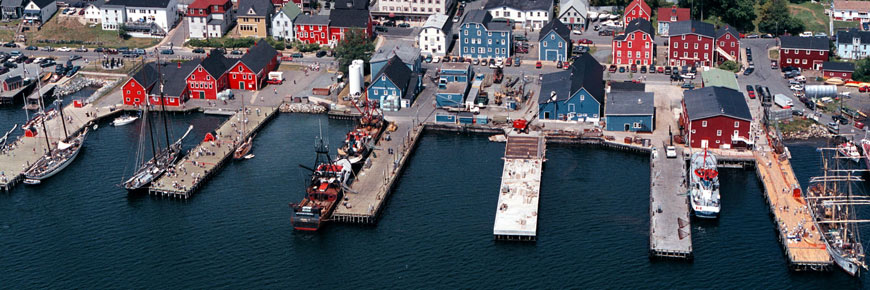
An aerial picture of Old Town Lunenburg
© Town of Lunenburg
Old Town Lunenburg
Nova Scotia
Date of Inscription: 1995
Old Town Lunenburg, where all streets are straight and all corners square, is the best surviving example of a British colonial policy of creating new settlements by imposing a pre-designed "model town" plan on whatever tract of wilderness it was the King's pleasure to colonize. At least 21 North American settlements, from Cornwall and Niagara-on-the-Lake in Ontario to Savannah, Georgia, and Philadelphia, Pennsylvania, benefited from this policy. But none has survived in such pristine condition as the town of Lunenburg on the south coast Nova Scotia.
Justification of outstanding universal value
Old Town Lunenburg was designated as a World Heritage site by UNESCO’s World Heritage Committee under the following criteria:
Criterion (iv): Old Town Lunenburg is a well preserved example of 18th century British colonial urban planning, which has undergone no significant changes since its foundation and which largely continues to fulfil the economic and social purposes for which it was designed. Of special importance is its diversified and well-preserved vernacular architectural tradition, which spans over 250 years.
Criterion (v): It is an excellent example of an urban community and culture designed for and based on the offshore Atlantic fishery which is undergoing irreversible change and is evolving in a form that cannot yet be fully defined.
Full description
The settlement was created in June 1753 as a home for 1,453 mostly German-speaking Protestant German, Swiss and Montbéliardian French colonists. The townsite, true to then-current convention, consisted of seven north-south streets, 48 feet wide (with the exception of King Street, which is 80 feet), intersected at right angles by nine east-west streets, each 40 feet wide, creating blocks that were further divided into 14 lots of 40 by 60 feet each. Each family received one town lot. The London-based Board of Trade and Plantations developed the plans without regard to local topography, which is why Lunenburg’s streets are never less than straight but sometimes dizzyingly steep.
There are some 400 major buildings within the old town, 70 percent of them from the 18th and 19th centuries, almost all of them wood, and many colourfully painted.
More Information
Town of Lunenburg:
Explore Lunenburg - History and Architecture
World Heritage Centre:
Related links
- Anticosti, Quebec
- Tr’ondëk-Klondike, Yukon
- Writing-on-Stone / Áísínai’pi
- L’Anse aux Meadows National Historic Site
- Nahanni National Park Reserve
- Dinosaur Provincial Park
- Kluane / Wrangell-St.Elias / Glacier Bay /...
- Head-Smashed-In Buffalo Jump
- SG̱ang Gwaay
- Wood Buffalo National Park
- Canadian Rocky Mountain Parks
- Historic District of Old Québec
- Gros Morne National Park
- Waterton-Glacier International Peace Park
- Miguasha National Park
- Rideau Canal
- Joggins Fossil Cliffs
- Landscape of Grand Pré
- Red Bay Basque Whaling Station
- Mistaken Point
- Pimachiowin Aki
- Date modified :